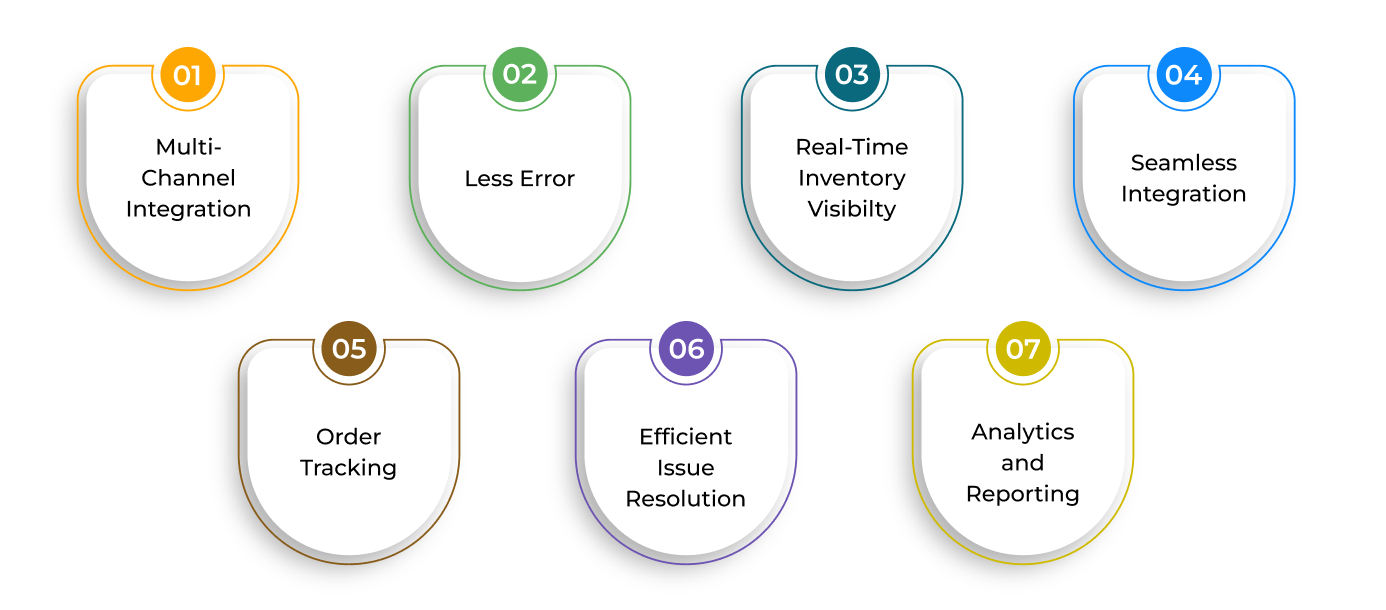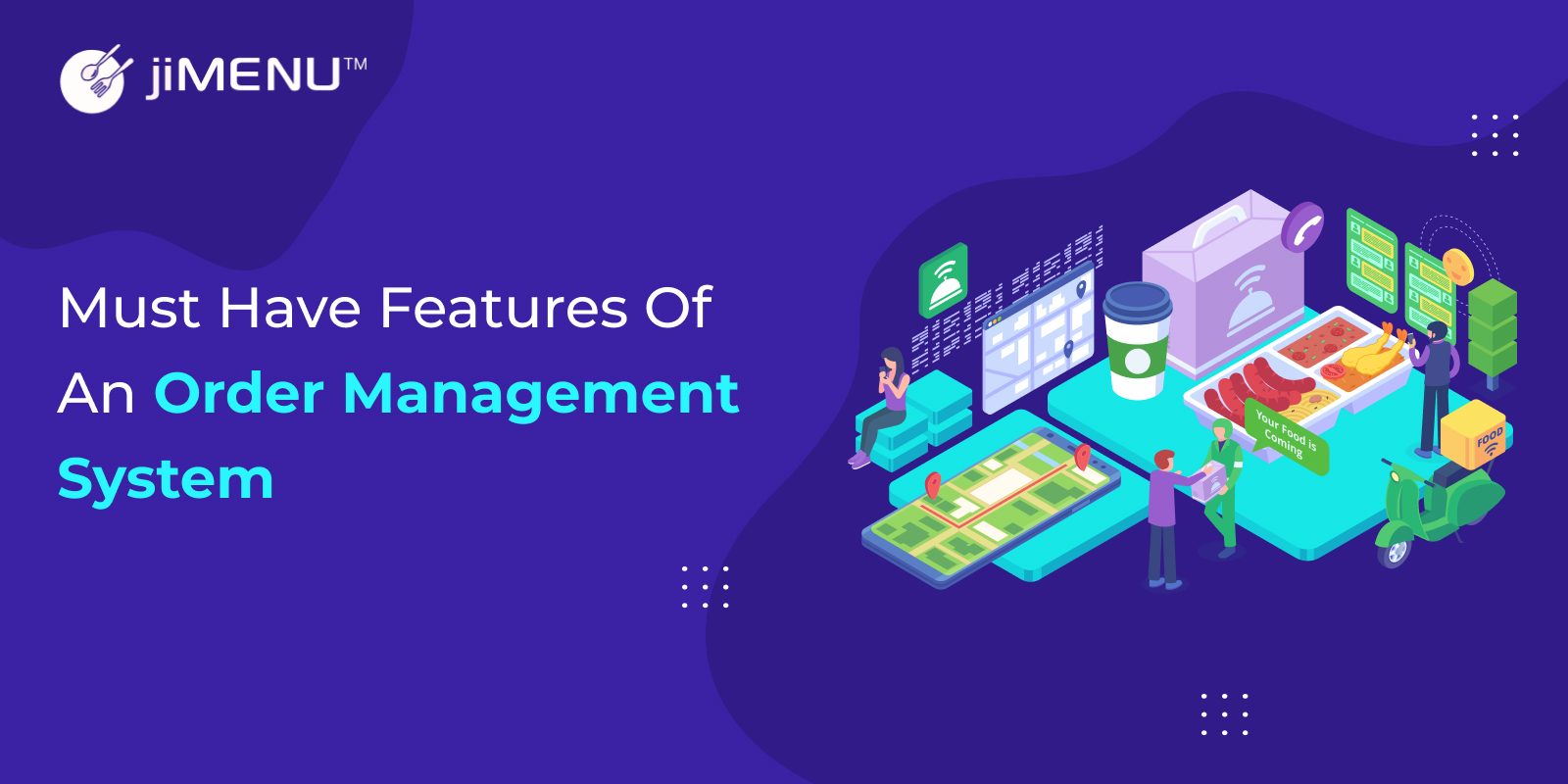In today’s competitive world, businesses cannot miss out on order management systems. A well-managed order management system helps them manage their orders more efficiently and effectively. This system streamlines operations by automating processes, including inventory tracking, order processing, shipping, delivery, and billing. It provides real-time visibility into all aspects of the order fulfillment process, so companies can make informed decisions.
Most Important Features of Order Management System
An Order Management System (OMS) is a crucial component of any business operation. It manages all sides of the order lifecycle, including receiving orders, updating inventory, generating labels, communicating with carriers, and sending customer updates. It helps businesses maximize operational efficiency and enhance customer satisfaction.
Here are a few features that businesses should consider before opting for an order management system:

- Multi-channel Integration: Multi-Channel integration is a crucial component of modern Order Management Systems (OMS). Nowadays, consumers interact with brands across various platforms, expecting seamless shopping experiences regardless of the channel used. Here is what makes multi-channel integration valuable for businesses:
- Seamless Customer Experience: A well-implemented multi-channel strategy improves brand reputation, customer loyalty, and lifetime value by enabling consistent interactions across channels. Consumers feel empowered to move effortlessly between online and offline environments, enhancing trust and credibility toward the brand.
- Sales Growth: By connecting multiple communication channels, an organization opens its doors to potential customers who might otherwise remain outside the company's reach. Additionally, integrating popular marketplaces allows businesses to broaden their audience and increase sales volumes.
- Less Error: Error reduction is a critical element of any Order Management System (OMS). It improves efficiency, reduces manual intervention, and mitigates errors during various stages of the ordering process. A reliable OMS will add features designed to minimize human errors and optimize processes.
- Automated Workflows and Processes: OMS automates repetitive tasks that help remove errors resulting from manual inputs or miscommunication. From receiving orders to generating confirmations, automated workflows eliminate opportunities for inconsistent or incorrect actions, ensuring accuracy.
- Decision Support Mechanisms: A decision support tool embedded in the OMS help users make informed choices. Moreover, integrated validation checks ensure accurate configurations and prevent errors.
- Data Validation and Verification: A good OMS considers incoming data, validating formats, lengths, numerical values, character sets, and other parameters before processing transactions.
- Customizable Alerts and Notifications: User-defined notifications and exception reports guide staff members in addressing issues immediately. It sends timely alerts about incomplete or incorrect orders, delayed shipments, or missing payment details to help teams react promptly to avoid downtime, lost revenue, or damaged customer relationships.
- Real-time Inventory Visibility: The real-time inventory visibility feature allows businesses to track their stock levels. It means that the stock level is automatically updated as an item gets sold, providing up-to-date information on product availability. With this feature, businesses can prevent overselling or underselling of items. Additionally, this feature helps businesses make informed decisions about reordering products. Overall, real-time inventory visibility improves efficiency and customer satisfaction.
- Seamless Integration: Seamless integration refers to the ability of different systems and software applications to communicate with each other without interruptions or disruptions. It means that all aspects of managing orders are integrated into one platform, making the process more efficient and effective for businesses. The integration occurs at multiple levels:
- Backend integrations: This involves integrating with ERP systems, inventory management tools, shipping providers, payment gateways, and CRMs so that there is a real-time exchange of data across these platforms. As a result, the OMS always has up-to-date inventory levels, accurate product availability, and current customer information.
- Frontend integrations: This aspect deals with ensuring a smooth user experience by providing intuitive interfaces on web stores, marketplaces, social media channels, mobile apps, etc., which allow customers to place orders easily from anywhere.
- Middleware integrations: These integrations ensure proper communication between frontend and backend systems so that data moves effortlessly between them. APIs play a crucial role here, helping streamline transactions and reduce errors caused by manual input.
- Data management: This ensures that every transaction made through the OMS is done accurately and stored securely. Data management helps companies make informed decisions based on real-world insights. Hence, analyzing historical trends is essential for optimizing future sales strategies.
- Automation: By automating routine tasks such as processing returns, handling refunds, generating tracking numbers, updating stock levels, and sending emails, businesses can save time and resources while reducing human error.
- Order Tracking: Order Tracking is a vital component of modern-day business and plays a vital role in any comprehensive Order Management System (OMS). Here are the elements involved in implementing successful Order Tracking in your organization. Order Tracking monitors the progress of individual orders, from placing the order until final delivery, ensuring that everything is running smoothly.
Here are some components involved in implementing robust Order Tracking capabilities:- Real-Time Updates: Providing up-to-date information to both internal teams and customers is critical. It helps businesses by sending live notifications via email, push messages, text alerts, or pop-up chatbots and keeps everyone connected and informed about changes regarding orders. Real-time update mechanisms eliminate confusion, reduce response times, and improve overall satisfaction among all stakeholders.
- Smart Notifications: Advanced notification systems take proactive measures to eliminate potential problems before they occur. For example, if weather reports indicate possible delays due to stormy conditions, proactively notifying customers and suggesting alternative shipping methods could mitigate dissatisfaction and enhance customer relationships.
- Omnichannel Support: In today's fast-paced digital world, consumers expect seamless and effortless customer experiences across multiple channels, including online, mobile, social media, email, and brick-and-mortar stores. It means businesses need to have a presence on these different channels and provide consistent support throughout the journey. An OMS with omnichannel support capabilities allows companies to manage orders and provide support through all these channels.
For example, if a customer places an order on your website but has questions about their shipment status, they should be able to reach out to your team via email or chat for assistance. With an effective OMS solution, businesses can ensure that their customer service representatives have access to accurate and up-to-date information about each customer's order history. You can enhance brand loyalty and improve customer satisfaction scores by providing this level of personalized, convenient support across multiple touchpoints.
- Customer Profiles: A Customer Profile feature in an Order Management System (OMS) refers to a central repository of data that gathers details related to individual customers, allowing retailers to gain deeper insights into their behavior patterns. Typically, a Customer Profile module offers users quick access to crucial information such as purchase history, browsing activity, return history, contact preferences, shipping addresses, payment methods, and other relevant demographic data.
Businesses can quickly identify trends and develop targeted marketing campaigns by keeping this valuable information in one location.
A robust Customer Profile functionality within your OMS helps strengthen client loyalty while streamlining operations by facilitating improved communication and maximizing the lifetime value of every customer relationship over time.
- Real-Time Updates: Providing up-to-date information to both internal teams and customers is critical. It helps businesses by sending live notifications via email, push messages, text alerts, or pop-up chatbots and keeps everyone connected and informed about changes regarding orders. Real-time update mechanisms eliminate confusion, reduce response times, and improve overall satisfaction among all stakeholders.
- Efficient Issue Resolution: The efficient issue resolution feature of an Order Management System (OMS) focuses on helping organizations address problems or concerns raised by customers or internal teams in real-time without affecting workflows.
- Workflow Automation: Workflow Automation in an Order Management System (OMS) refers to the ability of software applications to perform tasks automatically. Business leaders set specific parameters to tell how their systems process information and communicate with various departments via configuration and programming. Here are several advantages provided by modern workflow automation:
a) Streamlined Operations: Businesses reduce manual errors associated with repeated data entry and incomplete documentation. Standardization minimizes the risk of misinterpretations or oversights compromising operational efficiency or introducing security vulnerabilities.
b) Improved Decision Making: Automated workflow analysis helps in the easier detection of issues and impacts the timeliness or quality of services rendered. The data insights derived from integrated dashboards empower managers to make informed decisions improving overall effectiveness.
- Workflow Automation: Workflow Automation in an Order Management System (OMS) refers to the ability of software applications to perform tasks automatically. Business leaders set specific parameters to tell how their systems process information and communicate with various departments via configuration and programming. Here are several advantages provided by modern workflow automation:
- Analytics and Reporting: An effective Order Management System (OMS) incorporates robust analytics and reporting to understand customer behavior patterns, supply chain optimization initiatives, and inventory levels.
Analytics and Reporting modules often consist of dashboard visualizations, reports based upon KPIs, predictive modeling tools, and interactive storytelling via charts or graphs supporting more intuitive decision-making. A well-designed OMS analytics suite should provide cross-functional personnel access to meaningful information for identifying areas that need improvement.
Users should be able to use data, narrow down data into granular details, & share discovered insights with others throughout the organization through secure sharing mechanisms, preserving intellectual property integrity.
Overall, implementing advanced analytics and reporting functions within a comprehensive Order Management System benefits companies in thriving competition in the market.
Types of Order Management Systems
As a business owner, you have probably noticed that managing your orders can quickly become overwhelming without the proper tools. This is where an order management system comes into play.
There are numerous types of Order Management Systems (OMS) that exist to meet the needs of various industries and business sizes. Each type of OMS provides unique benefits to businesses depending on their size, complexity, industry vertical, and requirements. But with so many options in the marketplace, choosing the right one for your business can be challenging.
Here are a few steps to help you choose the right order management system for your system.

- Define Your Needs: The first step in choosing an OMS is understanding your needs. What are your current issues in managing orders? Are you having trouble keeping track of stock levels or accurately predicting demand? By identifying these areas where you need improvement, you can better determine which features and capabilities are most important in an OMS.
- Consider Integration Capabilities: Another major factor to consider when choosing an OMS is integration capabilities. Ensure that the OMS you choose integrates easily with your existing technology stack. It includes your website platform, payment gateway, and shipping carriers. Always look for vendors who offer robust APIs and integrations with popular platforms.
- Evaluate User Interface and Ease Of Use: The successful implementation of an OMS depends on user adoption. Ensure that the OMS has a clean, intuitive interface that makes sense to your team members responsible for managing orders. Consider scheduling demos with multiple vendors to see which platform feels the easiest to use and navigate.
- Assess Customer Support And Training Options: Implementing new software comes with potential issues along the way, especially if you have limited technical resources in-house. While choosing any OMS provider, ask about their customer support options and training materials.
Conclusion:
In summary, an Order Management System is vital in every stage of modern business. By investing in the right features, businesses can manage orders with accuracy. Doing so enhances their ROI and builds loyal customers. A well-chosen OMS can streamline operations and improve the inventory system, which enhances your business. Businesses can select an order management system that can help them grow their business by considering the above-mentioned features.
So, if you are looking for the most reliable order management system, consider trying jiMenu. It is one of the best and most innovatively designed solutions to cater to your restraint in an enhanced way. jiMenu has become the restaurant’s first choice because of its robust features, such as order management, contactless ordering, and more.












